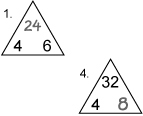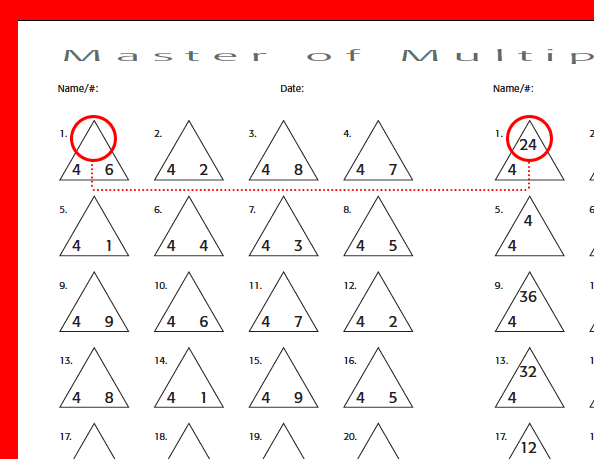
Multiplication Triangle Tests
What You Get
In this file you will find 9 reproducible practice sheets. There's one for each of the families from the 2's through the 9's. There's also a sheet with empty triangles so that you can create your own practice sheets.
On each sheet there are two sets of 28 problems. The problems are contained in triangles. The product is at the top, the factor of the family being practiced is at the bottom left and the other factor is at the bottom right.
For example:
On the product half of the 4's sheet, the triangle contains a 4 in the left corner and another factor--let's say 6--in the right corner. The product is written by the student.
On the factor half of the paper, the triangle contains a 4 in the left corner and the product--let's say 32--at the top. The student writes the missing factor in the bottom right corner.
What You Do
Have your students fold the paper in half so that the triangles are facing out. Lay the paper on the desk with the product side showing. Give them ninety seconds to complete just the product side. (I created two test timer songs you can download to make the time keeping a bit more playful and a lot more manageable.) When the time is up, have them circle the problems they didn't get to.
Students then unfold the papers and check their answers. (One nice aspect of these practice/test sheets is that they are self-correcting. Problem #1 on the product side corresponds to problem #1 on the factor side.) They then write their score as a fraction at the top. The number they had correct is the numerator and 28 is the denominator. Collect scores so that you can monitor their progress.
Ask them to study the factor side of the sheet for the next day's timed test. As they get better at knowing their facts, slowly reduce the test time until you get to the point where most of them can complete the test in one minute.
Why You Do It
Knowing multiplication facts is a key ingredient to math success. There's no getting around it. Additionally, these sheets lend themselves well to developing a number family awareness which is helpful when learning about fractions and division. Seeing the family sets over and over again during practice really helps to lay down a foundation of number relationships. I can't tell you how many times I've been able to use that skill.
Imagine we are all working together on a problem-solving activity and come upon this question:
"There are 24 desks in the classroom. There are 4 desks in each row. How many rows of desks are there in the classroom?"
When I see that a student or two is stuck, I just say, "Picture it. Now, triangle the numbers you're seeing." They get a funny look as they stare off into their own private math/memory land and, within five seconds, come back with the answer. It's pretty amazing.
Flash Cards
For some easy-to-make and easy-to-use flash cards that use the same triangular format as the practice tests, take a look at Origami Flash Cards. One little piece of paper can be used to show 8 different facts. Check it out.
